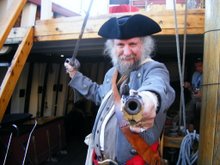The crew of the HMS Bounty had to abandon ship during Hurricane Sandy. Of the 16 member crew, 14 have been picked up by the Coast Guard after taking to the lifeboats. Two are still missing. Earlier reports had said that there were 17 crew members.
The ship had been on route from Connecticut to St. Petersburg, Florida and had tried to go around the storm.
The last anyone knows, the ship was still intact and floating.
The ship was built for the 1962 movie Mutiny on the Bounty. It was supposed to have been burned at the end of production, just as the original was, but star, Marlin Brando, refused to finish the movie unless the ship was preserved.
It has been in a number of other movies since then including PoTC: Dead Man's Chest.
I went through it last Summer when it participated in Opsail 2012. A crew member admitted to me that the copy is a bit bigger than the original in order to accommodate the film crew.
UPDATE: The 15th member of the crew was found but did not survive. She was Claudene Christian, age 42 and a relative of Fletcher Christian from the original Bounty.
Captain Robin Walbridge has not been recovered yet.
The ship itself sank in 18 feet of water and its masts are still visible. Hopefully it can be raised.
Monday, October 29, 2012
Tuesday, October 23, 2012
Navigation and the Parallel Ruler
One thing that I seldom see in navigational displays (including mine) is a parallel ruler. This was indispensable.
The parallel ruler is a pair of rulers connected by a pair of bars. The bars let you move the rulers apart but always keep them parallel.
In order to get from one place to another you need to know what course to use. One way to do this would be to use a protractor but period mapmakers usually provided ways of figuring your course without this. These require a parallel ruler.
One way was to include a compass rose on the map. You would mark the direction you need to follow then walk the ruler up to the compass rose to see what heading that corresponds with.
Period navigation was known as "loxodronic". Lines known as "loxodrons" would be drawn on the maps, usually in open spaces. These were conveniences and corresponded to headings. You lined up the course you needed to take then walked the parallel ruler across the map until you hit a corresponding loxodron. You then took your heading from the loxodron. These are longer than a compass rose and easier to match with.
The parallel ruler is a pair of rulers connected by a pair of bars. The bars let you move the rulers apart but always keep them parallel.
In order to get from one place to another you need to know what course to use. One way to do this would be to use a protractor but period mapmakers usually provided ways of figuring your course without this. These require a parallel ruler.
One way was to include a compass rose on the map. You would mark the direction you need to follow then walk the ruler up to the compass rose to see what heading that corresponds with.
Period navigation was known as "loxodronic". Lines known as "loxodrons" would be drawn on the maps, usually in open spaces. These were conveniences and corresponded to headings. You lined up the course you needed to take then walked the parallel ruler across the map until you hit a corresponding loxodron. You then took your heading from the loxodron. These are longer than a compass rose and easier to match with.
Subscribe to:
Posts (Atom)

